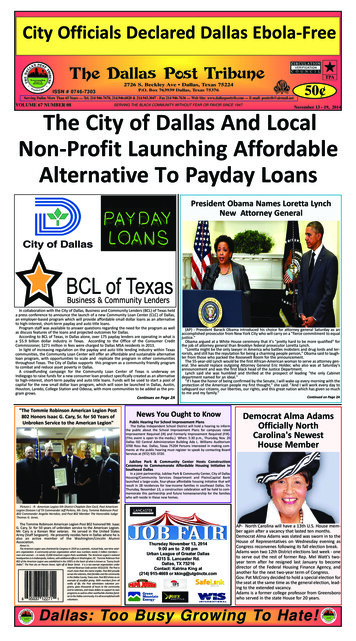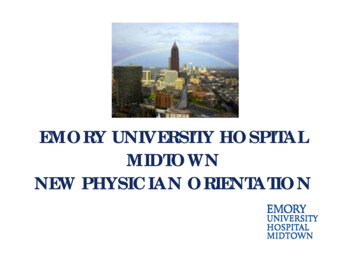
Transcription
Dallas Midtown Automated Transportation SystemConceptual Engineering StudyTechnology Scan White PaperNorth Central Texas Council of Governments1 0May 9, 2018Technology Scan White PaperNorth Central Texas Council of Governments
Technology Scan White PaperDallas Midtown Automated Transportation System Conceptual Engineering StudyProject No:Document Title:Document No.:Revision:Date:Client Name:Client No:Project Manager:Author:File Name:WFXO8000Technology Scan White Paper10May 9, 2018North Central Texas Council of GovernmentsN/AJeremy WyndhamBrian Burkhard, Craig Elliott, Stacy Learn, Marcus AshdownATS Technology White Paper-Dallas Midtown ATS Study-05.09.2018Jacobs Engineering Group Inc.1999 Bryan Street, Suite 1200Dallas, Texas 75201United StatesT 1.214.638.0145F 1.214.638.0447www.jacobs.com Copyright 2018 Jacobs Engineering Group Inc. The concepts and information contained in this document are the property of Jacobs. Use orcopying of this document in whole or in part without the written permission of Jacobs constitutes an infringement of copyright.Limitation: This document has been prepared on behalf of, and for the exclusive use of Jacobs’ client, and is subject to, and issued in accordance with, theprovisions of the contract between Jacobs and the client. Jacobs accepts no liability or responsibility whatsoever for, or in respect of, any use of, or relianceupon, this document by any third party.1
Technology Scan White PaperContents1.Introduction . 31.1History of the Modern Automated People Mover . 32.Automated People Mover (APM) . 52.1Bombardier INNOVIA APM 200/300. 62.2Mitsubishi Crystal Mover . 72.3Schwager Davis UniTrak . 83.Monorail . 103.1Bombardier INNOVIA Monorail 200/300. 103.2Hitachi Monorail . 123.2.1Hitachi Standard Monorail. 123.2.2Hitachi Small Monorail . 134.Cable-Propelled Systems . 144.1Doppelmayr Cable Car (DCC) Cable Liner Shuttle . 144.2Leitner-Poma Mini Metro. 165.Gondolas . 185.1Aerial Tramways . 196.Personal Rapid Transit (PRT) . 216.12getthere . 226.2Ultra Global . 236.3Vectus . 247.Group Rapid Transit (GRT) . 267.1West Virginia University Personal Rapid Transit . 267.2Vectus . 278.Automated Vehicle Shuttle . 298.1EasyMile . 298.2NAVYA . 308.2.1AUTONOM SHUTTLE . 308.2.2AUTONOM CAB . 328.3Local Motors . 338.4AV Shuttle Comparison. 349.Automated Vehicle Fleet . 359.1Waymo . 359.1.1System Operations . 359.1.2Testing . 3610.Future Technologies. 382
Technology Scan White Paper1. IntroductionThis Technology Scan White Paper is intended to provide a review of current industry usage of publictransportation vehicle capabilities. In particular, this paper puts forth transportation planning’s best practice in thecontext of automation. The purpose of this white paper is to inform and enlighten stakeholders of the DallasMidtown area on considerations as they move forward on building the development. It is also intended to serveas a means of outreach to engage stakeholders in the alternatives conversations to follow.The paper reviews technologies for Automated Vehicles and Fleets as well as more traditional Automated PeopleMovers, Monorail, Cable Propelled Systems and Personal and Group Rapid Transit.1.1History of the Modern Automated People MoverSome of the earliest modern-day Automated People Mover (APM) conceptswere developed in the 1950s when General Motors investigated driverlessvehicles on separate guideways. Later in that same decade, the New YorkCity Transit Authority briefly demonstrated an automated people moveroperation along 42nd Street between Times Square and Grand CentralStation. About a decade later, Westinghouse Electric Corporationdeveloped an APM technology called Skybus with federal funding providedby the U.S. Department of Housing and Urban Development. Skybusutilized transistor technology, rubber tires, and center guidebeam guidance.The system was called the South Park Demonstration Project for the PortAuthority of Allegheny County (PAAC). It operated between 1965 and1966, and while Pittsburgh’s urban transportation experiment did notsurvive, Westinghouse further developed the Skybus technology andimplemented a later version called the C-100 at Tampa InternationalAirport 5 years later as the first airport APM.1Figure 1. PAAC SkybusDemonstration Project1The construction of the Morgantown automated system in 1975 and the UMTA Downtown People Mover Program(DPM) highlights U.S. Government interest in PRT and APM systems in the 1960s-1970s as a less expensivealternative to other mass transit systems while promoting a more comprehensive approach to city planning. Thedevelopment of the Morgantown PRT system in West Virginia was supported by President Nixon as a USDOTPRT Demonstration Project as well as by UMTA development grants and is still operating today.The UMTA DPM encouraged cities to build APMs as downtown circulators as an alternative to more expensivemass transit systems. From 1976-1977 the UMTA selected Baltimore, Cleveland, Detroit, Houston, Indianapolis,Jacksonville, Los Angeles, Miami, Norfolk, St. Louis, and St. Paul for its DPM program. In the end, only Detroit,Jacksonville, and Miami constructed APMs, all of which are still running today.1Image: www.pghbridges.com3
Technology Scan White PaperFigure 2. Transportation Sec. William Coleman, right, looks at plans for Downtown People Movers in fiveU.S. cities in 1976. (AP Photo/Harvey Georges)2It was at this time, U.S. defense contractors diversified into transportation. Boeing supplied APM vehicles for theMorgantown (West Virginia University) automated system in 1975. LTV Aerospace Corporation (Vought) becamean APM supplier with an extensive project at the Dallas/FortWorth Airport (DFW), the 13-mile AIRTRANS system. ThisAIRTRANS technology served as the basis for the “JapaneseStandard APM Technology” that several Japanese APMmanufacturers licensed, including Kawasaki and Mitsubishi.Although the U.S. government’s investment during the 1960sand 1970s in new systems research and development wasaimed at urban 3 applications, APMs would go on to achievegreater success at airports throughout the world. Starting withTampa in 1971 and continuing to the present day, APMs havebeen instrumental in overcoming the problem of the growingscale of airports in terms of their configuration and passengervolumes. Today, there are over 100 APMs operating in airportand urban environments.Figure 3. Dallas/Fort WorthInternational Airport AIRTRANS3Recently, urban APMs are undergoing a resurgence in the USA. Several new systems using cable technologieshave been constructed in Las Vegas and Portland, Oregon. In addition, older APM systems are being refurbishedand/or redesigned, such as Morgantown and Jacksonville. In Dallas-Fort Worth, new construction and connectionsto DART light rail in Las Colinas have increased ridership on its APM and have led to the construction of a newstation, system refurbishment, and renewed interest in system own-people-movers-houstons-people.htmlImage: Lea Elliott4
Technology Scan White Paper2. Automated People Mover (APM)Introduction to APMsWhile classifying APMs by categories can be challenging and subject to debate as there can be overlap betweentechnology concepts, this report will present APMs into these generally-accepted categories: APM, Monorail,Cable Systems, Personal Rapid Transit (PRT) and Group Rapid Transit (GRT).Technologies that are within the APM category can be differentiated by the suspension and propulsion methodsused. Most vehicles are supported by the guideway on which they travel. This includes most monorails thatstraddle the top of the guidebeam and all other guideway-supported vehicles that are supported by rubber tires,steel wheels, pressurized air or magnetic levitation. However, suspended monorail technology hangs under theguideway as the name implies. The means of propulsion can be divided between those that are self-propelledwith on board electric motors, cable-propelled by a continuous cable along the guideway or guideway-propelledusing Linear Induction Motors (LIMs). While there can be on-board attendants, APMs are distinguished by theirability to be operated fully automated without drivers. The examples presented herein of automatic operationrequires an exclusive right of way. Examples of how guidance can be provided are by horizontally-mounted guidewheels that track side-mounted guide rails, guideway-mounted center guidebeam, the guidebeam itself,guideway-mounted center guide rail or traditional rails.The primary application of these systems have been at major activity centers, such as airports and city centers,but there are also numerous urban transit APM systems. These vehicles are typically supported on rubber tires,but also use steel wheels on steel rails. They operate using automatic, driverless control permitting more costeffective operations on short headways to minimize waiting time for passengers.APMs feature level boarding and operate under strict ride comfort parameters, permitting most passengers tostand thereby increasing passenger carrying efficiency to moderately high levels. The vehicles typically have twosets of doors on each side that allow all passengers including the mobility impaired in wheel chairs to board.System designs are proprietary and are not interchangeable with other APM technologies.The guideway of the APM system refers to the track or other running surface (including supporting structure) thatsupports, powers, contains, and physically guides APM vehicles designed to travel exclusively on it. APMs requirea separate and exclusive guideway that can be elevated, at-grade (fenced or otherwise protected) or in tunnels.The guideway structure itself is part of the APM facilities that is often, but not always, provided by other suppliers.Stations are located along the guideway to allow passenger access to the APM system. The station equipmenttypically includes automatic station platform edge doors and dynamic passenger information signs. The stationsalso have APM equipment rooms to house command, control, and communications equipment and other APMequipment. Boarding platforms can be side (on the outer sides of the guideway), center (in between theguideways), or triple (both outer sides and in between the guideways).A description of the Bombardier, Mitsubishi and Schwager Davis APM technologies and sample installations arediscussed in the following sections.5
Technology Scan White Paper2.1Bombardier INNOVIA APM 200/300Website: htmlBombardier Transportation, headquartered in Germany, is a division of Bombardier, Inc., a Canadian firm. Theyhave implemented over 30 APMs around the world of varying models. The most recent version of their selfpropelled, rubber-tired APM is the INNOVIA APM 200 and the INNOVIA APM 300. These two models are verysimilar. The INNOVIA APM 300 offers increased passenger capacity, higher top speed and an aluminum carbody.Figure 4. Bombardier INNOVIA APM 200, Dallas/Fort Worth Airport, TX, USA4Both systems are guided by a center guidebeam, utilize on-board rotary electric motors and can operate as trainsof up to 6 vehicles. Power is supplied via a “third rail” on the guideway and they operate fully automated withoutdrivers.Bombardier has three recent implementations of the INNOVIA APM 300 – one at the Munich Airport in Germany,one at the Dubai Airport in the UAE and one still underway at the King Abdulaziz International Airport in Jeddah,Saudi Arabia. The SkyLink APM at the Dallas-Fort Worth International Airport and the PHX Sky Train at thePhoenix International Airport currently utilize Bombardier INNOVIA APM 200 technology.Vehicle specifications for the Bombardier INNOVIA 200/300 are shown on the next page.4Image: Lea Elliott6
Technology Scan White PaperTable 1. Bombardier INNOVIA APM 200/300 vehicle specifications.2.2Bombardier INNOVIA APM 200/300 vehiclespecificationsValueVehicle length39.2 – 41.8 ft.Vehicle width9.4 ft.Vehicle height11.1 ft.Vehicle weight (unloaded)31,967 – 34,172 lb.Vehicle capacity (@ 4 passengers/m2)100 – 103Maximum speed37 – 50 mphMitsubishi Crystal MoverWebsite: http://www.mhi.com/products/transport/automated people mover.htmlMitsubishi Heavy Industries, Ltd., headquartered in Japan, has implemented over a dozen self-propelled, rubbertired APMs around the world of varying models. The most recent version of their self-propelled, rubber-tired APMis the Crystal Mover. The Crystal Mover is guided by side-mounted guide wheels running against guideway wallmounted guide rails. It utilizes on board rotary electric motors and can operate in trains of 1- to 6-vehicles. Poweris supplied via a “third rail” on the guideway and it operates fully automated without drivers. Miami InternationalAirport North Terminal will use Mitsubishi Crystal Mover APM technology.Figure 5. Mitsubishi Crystal Mover, Miami Airport, FL USA55Image: Lea Elliott7
Technology Scan White PaperTable 2. Mitsubishi Crystal Mover vehicle specifications.Mitsubishi Crystal Mover vehiclespecificationsValueVehicle length37.6 ft.Vehicle width8.9 ft.Vehicle height12.1 ft.Vehicle weight (unloaded)31,967 lb.Vehicle capacity105Maximum speed50 mph2.3Schwager Davis UniTrakWebsite: hwager Davis, Inc. (SDI) is a turnkey contractor in new system design, construction and installation includingsystem alignment, utility relocation, foundations, elevated cast in place or precast super structures, stationconstruction, electrical power feed, distribution and control system as well as the rolling stock.SDI implemented a 1.4 mi. fully-automated, fully-elevated transit system for Indiana University Health (formerlyClarian Health Partners, Inc.) and the City of Indianapolis. The system has three stations connecting three hospitalcampuses. SDI has continued to operate and maintain this installation.Figure 6. Schwager Davis UniTrak vehicle, IU Health, Indianapolis, IN USA66Image: SDI8
Technology Scan White PaperThe UniTrak vehicle installed at IU Health is classified as a small APM but could also be implemented as GRTbased on its car size. Each car of the 3-car train accommodates 8 seated and 19 standing passengers for a totalcapacity of 27 passengers per car. Each car is fully air-conditioned and has a single 4.9 ft. wide bi-parting doorfor station loading. The vehicles utilize rotary electric motors and run on rubber tires with horizontally mountedrubber guide wheels. While the trains at IU Health operate in 3-car consists, it is possible that SDI could configurethe UniTrak vehicle in single or 2-car configurations.SDI has identified itself as a transit supplier with the creativity and willingness to adapt its transit products to theproject-specific needs of Owners. Vehicle specifications are shown in Table 3.Table 3. Schwager Davis UniTrak car specifications.9Schwager Davis UniTrak car specificationsValueVehicle length22 ft.Vehicle width7.9 ft.Vehicle height9.8 ft.Vehicle weight (unloaded)15,000 lb.Vehicle capacity27Maximum speed28 mph
Technology Scan White Paper3. MonorailWhile monorail technology is typically considered a member of the APM technology category, for the purpose ofthis study it will be considered as its own category due to the unique nature that the guideway is utilized. Monorailscan be considered a rail-based transportation system however the rail in this case is a concrete beam (or steel)which the monorail vehicle “straddles.” Monorails are self-propelled with on board electric motors. While therecan be on-board attendants, monorails are distinguished by their ability to be operated fully automated withoutdrivers. Automatic operation requires an exclusive right of way. All other APM characteristics mentionedpreviously in Section 2 also apply to monorails including stations and guideways.Monorails offer high speed, high capacity, fully automated transportation with a major feature being the minimalguideway requirement of only the beam(s) elevated on single piers above the roads or streets. The beams areprecast off site using purpose designed forms that maintain the quality and the consistency of the shape andfinish.A description of the Bombardier and Hitachi monorail technologies and sample installations are discussed in thefollowing sections.3.1Bombardier INNOVIA Monorail 200/300Website: Bombardier Transportation, headquartered in Germany, is a division of Bombardier, Inc., a Canadian firm. Theyhave implemented four monorails in the USA of varying models with two additional installations underway. Themost recent version of their self-propelled, rubber-tired monorail is the INNOVIA Monorail 200 and the INNOVIAMonorail 300. These two models are very similar. However, the INNOVIA Monorail 300 offers walk throughcapability between cars. Both systems are supported and guided by a single concrete guidebeam, utilize on boardrotary electric motors and can operate as trains of 2- to 8-cars. Power is supplied via a “third rail” on the guidebeamand they operate fully automated without drivers. Both systems can be paired with Bombardier’s communicationbased train control, CITYFLO 650.Figure 7. Bombardier INNOVIA Monorail 200, Las Vegas, NV USA77Image: Bombardier10
Technology Scan White PaperCurrently Bombardier has one INNOVIA Monorail 200 operating in Las Vegas. Bombardier also has two INNOVIAMonorail 300 projects underway – one at the King Abdullah Financial District in Riyadh, Kingdom of Saudi Arabiaand the other in São Paulo, Brazil. Examples of a system implementation of the INNOVIA Monorail 300 areprovided further below.Table 4. Bombardier INNOVIA Monorail 300 car specifications.11Bombardier INNOVIA Monorail 300 carspecificationsValueVehicle length38.7 – 44 ft.Vehicle width10.3 ft.Vehicle height13.5 ft.Vehicle weight (unloaded)29,983 lb. per car (average)Vehicle capacity (@ 4 passengers/m2)86-95 per carMaximum speed50 mph
Technology Scan White Paper3.2Hitachi MonorailWebsite: http://www.hitachi-rail.com/products/rolling stock/monorail/index.htmlHitachi, Ltd., headquartered in Japan, has implemented a dozen self-propelled, rubber-tired monorails around theworld of varying models (nine are still in operation). The models are categorized as Small, Standard and Large(the large model is not presented here as the scale of the system is inappropriate for this study). Car specificationsof the Small and Standard models can be found in Table 5 below.All systems are self-propelled and rubber-tired. These systems are supported and guided by a single concreteguidebeam, utilize on board rotary electric motors and can operate as trains of 2- to 6-cars. Power is supplied viaa “third rail” on the guidebeam and they can be operated fully automated without drivers or manually-operatedwith drivers. Hitachi currently has no monorail systems operating in North America, but has several operating inJapan, South Korea, China, Malaysia, and UAE.3.2.1Hitachi Standard MonorailThe Hitachi Standard Monorail has been implemented as both fully-automated and manually-operated systemsHitachi has Standard Monorails operating in Tokyo, Okinawa, Dubai, and in South Korea.Figure 8. Hitachi Palm Jumeirah Monorail, Dubai, UAE, Fully-automated without driver88Image: Hitachi12
Technology Scan White Paper3.2.2Hitachi Small MonorailThe Hitachi Small Monorail has been implemented as a manually-operated system. This technology could alsobe implemented as a fully-automated driverless system. Hitachi claims that the Small Monorail capital cost is 50%less than a large-type monorail. Hitachi operates one of these systems in Singapore harbor.Figure 9. Hitachi Sentosa Express Monorail, Sentosa, Singapore (Manually-operated with driver)Table 5. Hitachi Standard and Small Monorail Car Specifications.13Car SpecificationsHitachi Standard MonorailHitachi Small MonorailVehicle length48.2 ft.24.9 - 32 ft.Vehicle width9.8 ft.8.2 ft.Vehicle height16.7 ft.15.3 ft.Vehicle weight (unloaded)52,600 – 55,000 lb. per car28,200 - 37,800 lb.Vehicle capacity82 per car43 - 49 per carMaximum speed37 mph37.5 mph
Technology Scan White Paper4.Cable-Propelled SystemsWhile cable-propelled technology is also considered a member of the APM technology category, for the purposeof this study it will be considered as its own category due to the unique nature that the vehicles are propelled.Cable-propelled transit systems can be categorized in two groups: 1) guideway-based and 2) aerial-based.Guideway-based systems are supported by wheels (rubber or steel) on a dedicated guideway or rails. Aerialbased systems are supported by an overhead cable or cables. Both groups are propelled by gripping (eitherpermanently or detachable) a moving cable traveling between stations. The vehicles are passive and propulsionis provided to the cable drive wheel(s) at the station(s).For the guideway-based systems, all other APM characteristics mentioned previously in Section 2 also apply tocable-propelled systems including stations and guideways. For the aerial-based systems, there is no guidewaystructure as the cables are supported by towers. Stations are typically at the two end points but can be locatedat points in between.While the guideway-based systems can be operated fully automated without drivers, the aerial-based systemstypically have attendants at the stations. Automatic operation requires an exclusive right of way. Passengercapacity per cabin can range from 4 for gondolas up to 120 for aerial tramways. Vehicle speeds can range from13-31 mph.A description of the Doppelmayr and Leitner-Poma guideway-based and aerial-based cable technologies andsample installations are discussed in the following sections.4.1Doppelmayr Cable Car (DCC) Cable Liner ShuttleWebsite: https://www.dcc.at/DCC Doppelmayr Cable Car GmbH & Co, headquartered in Austria, is a subsidiary of the Doppelmayr/GaraventaGroup. They have implemented nine cable-propelled systems around the world. The Cable Liner Shuttle isrubber-tired with horizontal guide wheels riding inside a steel guideway. The system is cable-propelled and canoperate as trains of 1- to 8-vehicles. They operate fully automated without drivers.DCC has two recent implementations of the Cable Liner Shuttle – one connecting the Oakland International Airportto the regional Bay Area Rapid Transit (BART) rail system and the other at the new Hamad International Airportin Doha, Qatar. Examples of system implementations of the Cable Liner Shuttle are provided further below.14
Technology Scan White PaperFigure 10. Doppelmayr Cable Liner Shuttle, CityCenter, Las Vegas, NV USA9Table 6. Doppelmayr Cable Car (DCC) Cable Liner Shuttle vehicle specifications.9Doppelmayr Cable Car (DCC) Cable LinerShuttle vehicle specificationsValueVehicle length (1 car)19.7 ft.Vehicle width9.8 ft.Vehicle height11.3 ft.Vehicle weight (unloaded)11,023 lb.Vehicle capacity (1 car @ 4 passengers/m2)56Maximum speed31 mphImage: Lea Elliott15
Technology Scan White Paper4.2Leitner-Poma Mini MetroWebsite: http://en.minimetro.com/HomeLeitner-Poma of America is based in Grand Junction, Colorado. It is the North American subsidiary of Frenchbased Poma, which is owned by the Italian company Leitner Technologies, part of the Leitner Group. Theycurrently have approximately 20 cable-propelled systems and funiculars implemented around the world. The MiniMetro can be rubber-tired, steel-wheeled or air-levitated (Hovair ). The system is cable-propelled and can operateas trains of 1- to 4-vehicles. They operate fully automated without drivers. Leitner-Poma systems can currentlybe found in operation at airports in Minneapolis-St. Paul, Detroit, Zurich, and Cairo,Figure 11. Leitner-Poma (formerly Poma Otis) Mini Metro utilizing steel wheels/steel rail guidance,Minneapolis-St. Paul Airport, MN USA10Table 7. Leitner-Poma Mini Metro standard vehicle specifications.10Leitner-Poma Mini Metro vehiclespecificationsValueVehicle length (1 car)48.9 ft.Vehicle width9.4 ft.Vehicle height12.7 – 13.5 ft.Vehicle weight (unloaded)33,069 – 35,274 lb.Vehicle capacity (1 car @ 4 passengers/m2)66 – 70Maximum speed27 mphImage: Lea Elliott16
Technology Scan White PaperThe Mini Metro system is also available in a smaller cab configuration. Leitner-Poma currently has one system,called Squaire Metro, operating at Frankfurt International Airport.Figure 12. Leitner-Poma Mini Metro small vehicle on The Squaire metro, Frankfurt Airport, Germany11Table 8. Leitner-Poma Mini Metro small vehicle specifications.11Leitner-Poma Mini Metro small vehiclespecificationsValueVehicle length (1 car)18.1 ft.Vehicle width6.9 ft.Vehicle height9.5 ft.Vehicle weight (unloaded)7,716 lb.Vehicle capacity (1 car @ 4 passengers/m2)33Maximum speed16 mphImage: Leitner-Poma17
Technology Scan White Paper5. GondolasWebsite; https://www.doppelmayr.com/en/products/Website: http://leitner-poma.com/products/In Gondola systems, cabins are propelled and supported by the same cable which is suspended from poles ortowers. The cabins are small and typically carry 4-15 passengers per cabin. Gondola cabins can also besuspended by two or three closely-spaced cables. Cabins loop around the system. At the end stations, cabinsare detached from the cable and are mechanically pulled around a semicircle. Rubber wheels accelerate anddecelerate the cabins withou
an APM supplier with an extensive project at the Dallas/Fort Worth Airport (DFW), the 13-mile AIRTRANS system. This AIRTRANS technology served as the basis for the "Japanese Standard APM Technology" that several Japanese APM manufacturers licensed, including Kawasaki and Mitsubishi. Although the U.S. government's investment during the 1960s










